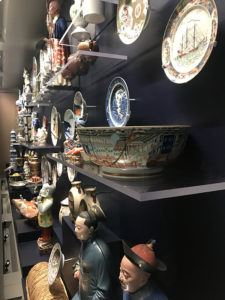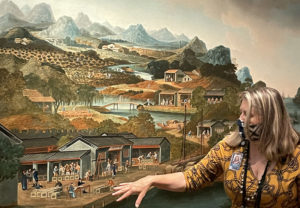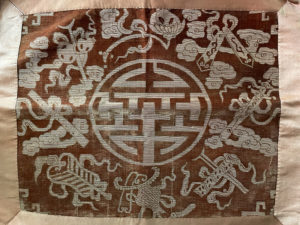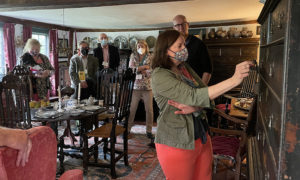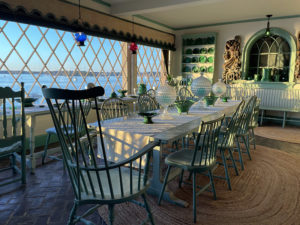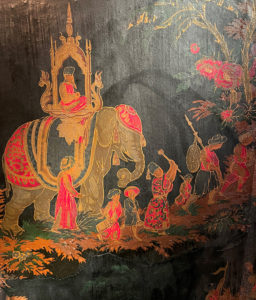Asian Exports and Influences Abound on the North Shore
EVENTS > STUDY TRIPS ABROAD
FALL 2021 SYMPOSIUM IN REVIEW
by Matthew A. Thurlow
Over the course of six days in September, Trust members rambled across Essex County, MA, in search of exemplary art, landscapes, and architecture during our first multi-day, in-person event since the pandemic began. Our exploration centered on Salem, a port city from where vessels plied the transatlantic and transpacific trade. Now largely remembered within colonial American lore for the infamous witch trials of 1692–93, our bout of mass hysteria was solely focused on the impressive museum collections and historic architecture that abound in this region, with the Peabody Essex Museum (PEM), Trustees of Reservations (TToR), and Historic New England (HNE) serving as gracious and welcoming hosts.
Perhaps surprising some participants, Salem was among the most cosmopolitan cities in the early years of nationhood. The owners and supercargoes of the vessels plying the seas gained wealth but also an extensive awareness of the cultures and natural phenomena encountered abroad, embodied in the material goods transported back to Massachusetts. Our travels provided a meaningful opportunity to explore the decorative arts collected in northeastern Massachusetts, much of which demonstrates the influence of Asian encounters and of the blending of aesthetics and the meaning derived from these objects.
PEM is perfectly suited to explore the intricacies of this complex subject. Yin Yu Tang offers an immersion into Chinese domestic life, and the recently revamped Asian Export Art galleries are truly stunning. The extraordinary quality and depth of the collection is on full display as is the extensive scholarship and nuanced interpretation which represents not only China and Japan, but also Indonesia and India (figure 1). Under the headings of Catalysts, Connections, and Transformations, curators Karina Corrigan and Lan Morgan introduced the essential yet difficult topics tied to the trade and colonialist pursuits that generated the bulk of PEM’s holdings (figure 2). The silver and opium Western merchants exchanged for cotton, tea, and porcelain created fraught dynamics of international trade that continue to ripple around the world. The transfer of artistic design and production resulted in creative cultural hybrids but at great cost to those extracting the silver and consuming the opium.
TToR’s Stevens-Coolidge House in North Andover, MA, showcases the Colonial Revival influence of early preservation architect Joseph Everett Chandler. We were fortunate to have the opportunity to learn about recent discoveries from curatorial intern Katharine F. Grant. During John Coolidge’s extensive travels prior to and following his marriage to Helen Stevens he brought an array of Asian goods back stateside, and the couple also collected Chinese decorative arts at auction in the United States. Thus, the origin of a set of seven 19th- or early-20th-century Chinese cut velvet seat covers (figure 3) is murky, but a portion of the fabric was used to upholster a set of four c. 1800 ladder-back chairs. We wonder whether the Coolidges and Chandler understood the meaning of the Chinese symbol for hua (meaning flower) incorporated into the design, but textilians are fortunate that three seat covers survive in unused condition.
While visiting a private collection displayed in a historic house in Newbury, Trust Governor Tara Cederholm discussed a c. 1710 japanned high chest from Boston, where this style of Asian-influenced ornamentation took root in the early 18th century (figure 4). Over the past decade, Tara has conducted a comprehensive analysis of japanning in partnership with furniture conservator Christine Thomson. Although japanned furniture was primarily an 18th-century phenomenon, Tara and Chris have also explored examples of 19th-century revivals of the style that indicate a sustained interest in this form of Chinoiserie design, including a set of chairs associated with the Gardner family.
For many symposium participants, the opportunity to visit HNE’s Beauport was akin to a religious pilgrimage. Overlooking Gloucester Harbor, Beauport, a.k.a. the Sleeper-McCann House, was the home, laboratory, and salesroom of Henry Davis Sleeper, one of America’s earliest interior designers (figure 5). Sleeper experimented with a variety of styles as the house grew and evolved, and his fondness for Asian design is clear in the export wallpaper found in the China Trade Room, the Belfry Chamber (see p. 2), and the Strawberry Hill Room, his homage to the 18th-century English aesthete Horace Walpole. The latter depicts figures parading in a lush landscape, including gentlemen on top of camels and elephants (figure 6). Reproduced as an upholstery fabric in 1985 through Brunschwig & Fils under the title “Beauport Promenade,” this paper embodies a design continuum that stretches across three centuries.
Much contemporary curatorial discourse is devoted to the topic of cultural appropriation, the process by which an artist’s or designer’s inspiration is found in sources outside of their own surroundings. An appreciation for foreign style is reduced to appropriation when the means or ends are harmful to the society from which a design is derived. Through our travels with the Trust stateside and overseas, we have encountered countless byproducts of cultural exchange, leading to questions about the line that divides a taste for exoticism from that of appropriation. As we become more facile with this lens of artistic inquiry, our grasp of the forces that define appropriation will improve, and we will gain a fuller understanding of the intersection of beauty and meaning represented by the art we encounter. Our time in Essex County certainly provided plenty of material culture to admire and carefully consider, offering fodder for this essential conversation.
Matthew A. Thurlow is the Executive Director of the Decorative Arts Trust.
A print version of this article was published in The Magazine of the Decorative Arts Trust, one of our most popular member benefits. Join today!
Complete a digital puzzle from this trip on our Puzzles webpage!

